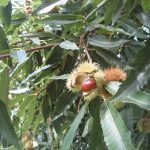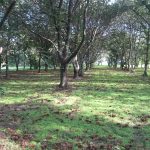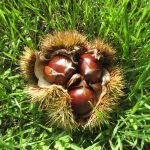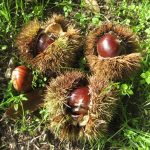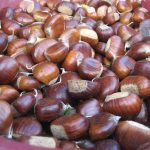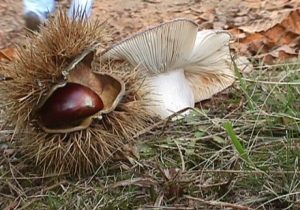
Name
Chestnut
Seal of quality

Protected geographic Indication- PGI. (IGP) Regolamento (CE) N. 1050/2007 del 12 settembre 2007
Currently in the phase of “provisional protection” at a national level and awaiting community recognition).
Description
The protected geographic indication “Castagna Cuneo” is reserved for fresh and dried fruits, obtained from the sweet chestnut woods ( Castanea sativa ) of the following varieties traditionally grown in our valleys: Ciapastra, Tempuriva, Bracalla, Contessa, Pugnante, Sarvai d’Oca, Sarvai di Gurg, Sarvaschina, Siria, Rubiera, Marrubia, Gentile, Verdesa, Castagna della Madonna, Frattona, Gabiana, Rossastra, Crou, Garrone Rosso, Garrone Nero, Marrone di Chiusa Pesio, Spina Lunga. The product obtained is excluded from coppices, composite coppices, timber plantations deriving from aged coppices, even though of the species mentioned, and from interspecific hybrids.
In the fresh condition, the Castagna Cuneo presents minimum sizes of 110 fruits per kg, outer colouring of the pericarp from light brown to dark brown, a more or less large hazel-coloured cicatricle, never going over the lateral faces, radial shaped, the epicarp goes from yellow to light brown, usually with a crispy consistence and a sweet and delicate taste. More than 10% of internal or external defects of 10% are not admitted (split, rotten, mouldy or containing maggots).
Apart from the fresh product, the dried Castagna Cuneo is also available on the market, a product obtained with the traditional technique of drying over a low flame in special brick structures, the so-called dryers or “secou” in dialect. The weight of the product, which is obtained after 30-40 days of drying, is approximately one third of its original weight. The dried Chestnut is presented shelled,, whole, healthy, a light straw colour, and with no more than 10% of defects (traces of maggot eating, deformation, splitting, fruits with traces of pericarp etc.), with humidity of the whole dried fruit not exceeding 15%.
Among the processed products, in conformity with the IGP disciplinary regulations, only the products obtained exclusively from IGP chestnuts can bear the name Castagna Cuneo, without, however, the community logo, for example chestnut flour.
Nutritional characteristics
Chestnuts are an atypical fruit, since they have a high content of complex carbohydrates (starch) like cereals. They are a good source of fibres, potassium, vitamins of the B group, above all B1 and B6. Cooking transforms a part of the starch into simple sugar, which is what gives this chestnut its typical sweet taste.
| FOOD | unit of measurement | Chestnuts | Chestnuts secche |
|---|---|---|---|
| Edible part | % | 85 | 100 |
| Water | g | 55,8 | 10,1 |
| Protein | g | 2,9 | 6 |
| Fat | g | 1,7 | 3,4 |
| Carbohydrates | g | 36,7 | 62 |
| Starch | g | 25,3 | 41,7 |
| Soluble sugar | g | 8,9 | 16,1 |
| Total fibre | g | 4,7 | 13,8 |
| Energy | kcal | 165 | 287 |
| Kilojoules | kJ | 688 | 1201 |
| Sodium | mg | 9 | 17 |
| Potassium | mg | 395 | 738 |
| Iron | mg | 0,9 | 1,9 |
| Calcium | mg | 30 | 56 |
| Phosphor | mg | 81 | 131 |
| Thiamine | mg | 0,08 | 0,15 |
| Riboflavin | mg | 0,28 | 0,52 |
| Niacin | mg | 1,11 | 2,07 |
| Vit A ret. eq. | mcg | 0 | 0 |
| Vit C | mg | ||
| Vit E | mg |
Area of production
The area of production of the “CASTAGNA CUNEO” I.G.P. includes the mountain and valley-bottom communes of all the valleys of Cuneo , from Valle Po to Valle Tanaro.
History
The origins of Chestnut-growing in Cuneo go way back in time, the first references dating back to the 12th century (Correspondence of the Certosa di pesio: 1173 – 1277). White chestnuts are mentioned in documents of the Communes of Envie and Martiniana Po dating back to 1291.
The first indications relative to the method of protecting fruit chestnut woods can be found in the communal Statute of the towns of the Val Tanaro dating as far back as 1300, whereas indications relative to the sanctions to be applied in case of illegal or fraudulent picking of the fruits are written in the Statutes of Gambasca Lesegno, Chiusa Pesio and Sanfront (Tamagnone, 1969; Barelli Di Quarti, 1966; Botteri, 1982).
Evidence of the diffusion in many areas of the province of Cuneo of the techniques of chestnut drying for the production of dried chestnuts and chestnut flour, lies in the fact that we can still observe the presence of numerous drying sheds built around the 15th – 16th century. Cuneo was already an extremely active market in the 16th century. The origins of the market of Vernasco also date back to the same period.
In the 19th century, the chestnut continued to be at the centre of mountain farm life organization. In fact, it represented an essential component of the diet of the families and one of the few possibilities of trading and of subsequent financial incomes of the mountain areas. In the 50s of the last century, a crisis began related to the exodus of the alpine populations towards the bigger cities and abroad then, in the 80s, there was a recovery of the production linked essentially with the rediscovery of the quality of this fruit.
Procedures for acknowledgement of the Protected Geographic Indication began in 1999. Connected with this acknowledgement, the “Consorzio per la Valorizzazione e la Tutela della Castagna Cuneo IGP” was founded, and is based in Cuneo , Via Bruni 5.

